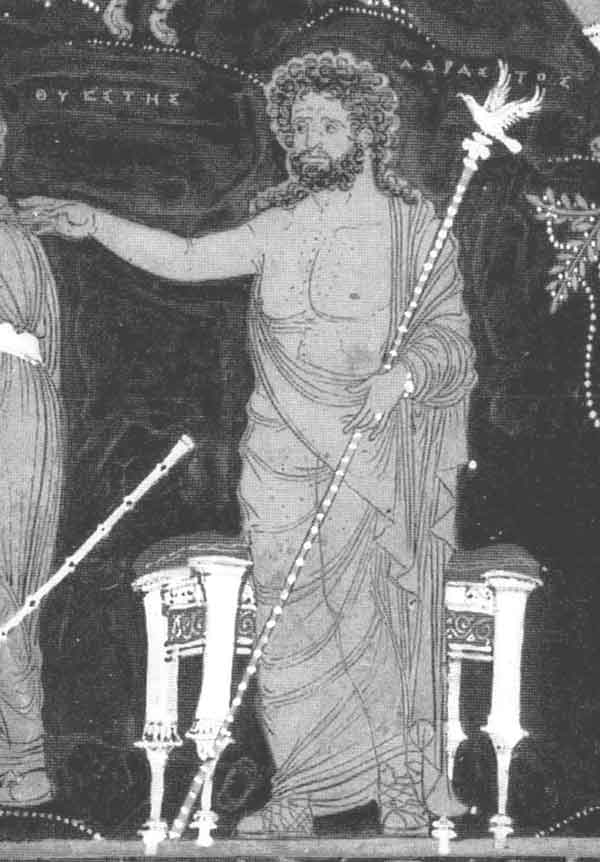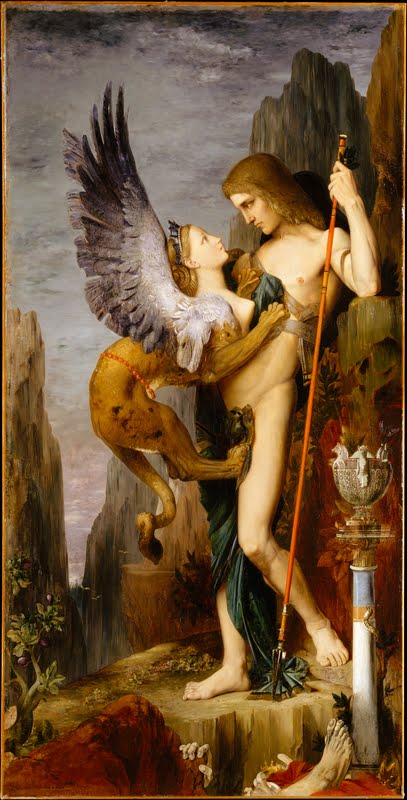.
Adrastus King of Argos and Sicyon, Dareios Painter Vase
>ORACLES AND GUESTS IN THE HOUSE OF ADRASTUSBut let us return to the conversation at Simmias’ bed-side.
Theocritus continued to defend the idea of the protective spirit of Socrates with great enthusiasm. This was understandable: he himself passed for an expert on the business of auguries and oracles. And his opponent, Galaxidoros, did not deny in the least that the future can be guessed at; he merely ridiculed certain naïve ways of understanding how this could be done through signs.
“By themselves”, he continued, “they are trivial; they are but inconclusive evidence by which the powers that be announce their intentions, events barely in the course of shaping themselves, barely approaching the door of the present. But there should not be anything surprising in this; the soothsayer’s art is not supernatural. After all, the cries of sea birds, or tiny clouds in the sky, announce to the sailor the approaching storm.”
From the very beginnings of the human race, and in all parts of the world, things have been that way: there was a certain fear of the future; but also a curiosity; and the impression that the good and evil forces around us can be recognized through certain subtle signs; and if only one could identify and understand these subtle signs… Hence the belief in oracles; and hence great respect for those who could recognize these signs – whether from the flight of birds, or their entrails, or from dreams, or even from – sneezes. It has always been so with all peoples. But what surprises us about Greeks is that in their case these beliefs and practices have coexisted with a critical, inquiring, even contrary mind. It has so often happened among Greeks that within one man one found great intellectual, critical, rational talents and the superstitious belief that gods reveal their intentions and desires through signs or even inner voices. Even Plato himself said that auguries are a bond of friendship between men and gods! Powerful states were sending official embassies to consult the oracle of Apollo in Delphi regarding the most crucial matters of state business. Every town maintained official soothsayers, whose opinions were consulted before any decisions. In every country of Greece there were shrines dedicated to gods and heroes where pilgrims went because there, by diverse methods, future was said to be regularly revealed. Especially many such oracles were found in Beotia, the land in which Thebes was located, and soothsayers like Theocritus enjoyed here particular popularity.
But if the plotters took seriously the soothsaying skills of Theocritus, why did none of them turn to him with the question:
“Will the expedition be successful? Will our friends in Kithairon arrive here safely? Will we be able to liberate our fatherland together?”
These questions must have been foremost in everyone’s mind at Simmias bedside: after all, the turn events were to take that day would influence not only the history of their city, but perhaps also determine whether they themselves lived or died. They thought about it constantly – about it and perhaps about nothing else; and only covered their tension with their pretended curiosity regarding the status of sneezes as potential omens. Perhaps they were simply too afraid to ask, reasoning that whatever happens, it is better not to know in advance, since it is in any case already too late to go back?
Yet another consideration may have worried them, though no one would have mentioned it: the first expedition of seven against Thebes ended in disaster and it had been preceded by very evil omens which, nevertheless, the leader of the expedition chose to ignore. Of course, he could have pointed to other auguries which in fact commanded him to wage war. All of this was reported in various versions in the myths, and drama and poetry presented it ever more colorfully. But if one assumes that behind all the legendary tales there lie indeed some real events from the Mycenaean Era, then one might assume that the first scene of the drama happened more or less like this:
That night, the night on which everything began, Adrastus slept poorly; it was muggy, from somewhere far away wafted in the threatening growls of thunder. The prince kept waking; and whenever he did, the old worry came to him: those strange words whose meaning he was unable to penetrate. They said: you will marry one daughter to a lion, the other – to a boar!
Oracles always spoke the language of metaphor; the art of understanding them lay not in taking the answer verbally, but in discovering the right key for interpretation. Therefore, in this case, does the oracle mean men whose names perhaps are derived from “lion” and “boar”? But there are many such names; besides, such an interpretation seemed much too straightforward. Or does the oracle concern men whose character will be market by the courage and fierceness typical of these animals?
Larissa, the city which Adrastus ruled, lay on a hill, at the edge of the fertile plane of Argos; in later times the city was to take on the name of the surrounding plane, and the name Larissa to become limited to its castle hill alone. Beautiful and fertile Argos lay in the north-east of Peloponnesus. In it there were many principalities, cities and castles, whose lords would have been glad to enter into a marriage alliance with the mighty house of Adrastus, but he was not interested. All his neighbors, the near as well as the far, were constantly at odds – over land, or cattle, or women. Alliances were constantly shifting; there were frequent bloody battles and treacherous raids. Yesterday’s enemies became friends for a day only to plunge their sword in today’s ally’s back tomorrow. Adrastus has done well in this small community; he was considered a very agile operator. But when the time came to marry off his daughters – two for now, the third not yet being of age – a new kind of trouble, one which he did not know how to handle, appeared. Whom to choose for sons in law? There were many candidates and therein lay danger: those rejected might band together and raid Larissan territory. And, besides, one will have to pay two dowries!
For these reasons, Adrastus turned to the Delphic oracle for advice but the advice he received appeared useless. Where was he supposed to look for a lion and boar, kings of wilderness, who might defend their father in law? The prince was very worried; human wits failed him; gods’ word was no help.
Adrastus slept alone, in a room upstairs. The house of the basileus of Larissa was not especially large; it hardly differed from those of some of his subjects. Downstairs was the great hall; it was called megaron. A fire burnt there permanently; at its side the householders ate their meals, made sacrifices to gods, and received guests. Small rooms next to it, and upstairs, served as bedrooms. They were furnished quite simply: animal skins, small stools, chests. One rose early and spent whole days out of doors – working in the fields, herding cattle, hunting, or raiding. But when the dark night descended, one sat at the megaron fireside for many hours, talking, telling ancient tales, and singing. Here was the center of family life on rainy or cold days.
Suddenly, some sort of strange noise woke Adrastus from the torment of half-sleep. He sat up, frightened. Was it armed men trying to break down the gate? Was it fighting? He could hear the clangor of swords against shields, yelling, and cursing. It was not an unusual thing in those days: an unexpected raid by pirates who’d arrived at the shore after dark; for this reason, cities were never built at the shore. Adrastus had repelled many such attacks; and had taken part in many: he was always prepared for a fight. But what frightened him now was the strange silence within the house. Why is no one up? What are the servants doing? Where are the women? Did gods put them all to sleep? Is this – treachery?
Adrastus jumped up, grabbed his sword and shield – weapons had to always be close to one’s side – and leapt downstairs, into the megaron. But the great hall was empty. Even the fire was very low: no one was tending to it. The prince ran outside. There he saw his people: the servants crowded at the gate; others stood on the wall, holding up torches. But no one seemed frightened; on the contrary, there were laughter and joyous cries.
When the prince ran up to the top of the gate, he saw below him two armed men. They faced each other, wearing helmets and chest plate and holding swords and shields at the ready; they looked like two wild animals readying to pounce on each other. Further away there stood their chariots and help. Adrastus saw this in an instant and immediately understood: these two princes had arrived at his gate simultaneously, hoping to find refuge from the approaching storm; then they quarreled over which one had the right to knock on the gate first.
But before he managed to call out to the men before, Adrastus saw something which filled his heart with pious fear and hope: the helmet of one of the men, the shorter one, was decorated with boar’s fangs; on the shield of the other was painted – a reclining lion!
Tydeus was short, stocky, and grim. He resembled a boar. He spoke rarely and tersely. He seemed a terrible barbarian; his speech had a foreign, rasping sound, and his weapons, too, differed from those normally worn by the knights of Mycenae, Tiryns, Thebes or Athens. In fact, he had come from very far away. His fatherland lay in the high and wild mountains which stretched west of Beotia all the way to he sea; it was called Aetolia.
But his descent was magnificent, royal. The cause of his exile was also famed; even before his arrival itinerant beggars and singers passing through Larissa had told the tale of the misfortune which came upon him by the will of gods and fate. These vagabonds told their stories to pay for the place at the megaron fire, a cup of wine, a piece of cake, a place to sleep in the stables at night: they brought the news and gossips, sometimes adding a bit from themselves to make it all more interesting and to earn a better welcome. But if there were no recent news worthy of telling, they retold old stories, singing tales of gods and heroes. Thus, by the time Tydeus retold his story by the megaron fireside, muttering reluctantly – “I killed a relative. Not intentionally. It was on a hunt” – the prince did not learn anything he hadn’t heard already. And he understood immediately, without any need to hear pleas or explanations, what the stranger wanted: pursued by his family, he hoped that perhaps at last here, beyond the sea, he might find a safe welcome and a host who might aid him in performing the sacred ritual of purification to clear him of the stain of innocent blood. And Adrastus was ready to do all this gladly. Here is a prince from a distant land, strong and brave, a son in law indicated by the oracle!
It was Tydeus who was surprised that night then. Despite his natural aloofness, he was unable to hide his surprise when he heard the words:
“Very well. I accept you in my household. I will purify you of your ritual pollution and then I shall return you to the throne in Aetolia which is rightfully yours, by force if I must. And I shall give you my daughter for wife.”
Adrastus then immediately turned to the young man sitting on the other side of the fire; tall and handsome, with regular facial features and lively eyes, he seemed the very opposite of Tydeus. The lord of Larissa said to him:
“As to you, Polyneices, I give my other daughter. And I shall return you to your throne, too. It is justly yours, I know, not your brother’s. I shall return you to your throne first because it will be on my way… because then, together, we shall all set out from your Thebes to Tydeus’ Aetolia!”
There was great pride in the words of the prince of Argos; at the same time, he felt indebted to the oracle, which until so very recently had worried him. How wise and omniscient, and how generous towards his house, is the God of Delphi! The fact that the princes are from far away, and that they are landless, is the best of all gifts he could have ever expected from fate. It will not be necessary to provide the daughters with large dowries: fat cattle and fiery battle stallions can now remain in his stables. Of course, while they remain by his side, the princes will receive land in lease and he will deny them nothing; but only until the time of the expedition comes.
Adrastus was not afraid of the coming war; on the contrary, he was looking forward to it with great joy. He loved adventure and battle, and above all – he loved war booty. And when Polyneices and Tydeus settle at last in their own ancestral palaces, he, Adrastus, will be counted among the most powerful of princes of Greece: three rich lands will be united in his clan: Larissa, Aetolia and Thebes; and Thebes, the famed, rich Thebes most of all!
Nothing that happened in the megaron of Adrastus’s house that night was somehow extraordinary. Exiles from far-away lands often knocked on the doors of powerful men. Usually they were received very hospitably, because this was required by ancient laws of gods and men. Of course, not every exile could count on receiving his host’s daughter in marriage; but this also happened sometimes, if one is to believe myths and epics. After all, marriages were usually contracted mainly with the view towards advancing family business and property. No one asked young girls their opinion; and the young men did not have to worry about the girl’s looks, as long as they were healthy and their dowries good. Love could always be found in some other way – with a war slave, for example.
The shield of Polyneices stood leaning against a wooden post. It was rectangular and very large. Every time more wood was thrown into the fire and the flames leapt up, the concave surface, covered with bronze plate, burnt with a dull red glow. One could then see clearly: the beast represented upon it had only the torso and paws of a lion, but its head was that of a young woman and out of its back there grew powerful bird wings. Thus in the glow of the fire, as the great marital and military plans were hatched in the darkness of the megaron, there lit up and died down by turns that mysterious beast: the Theban sphinx.


























































.jpg)


